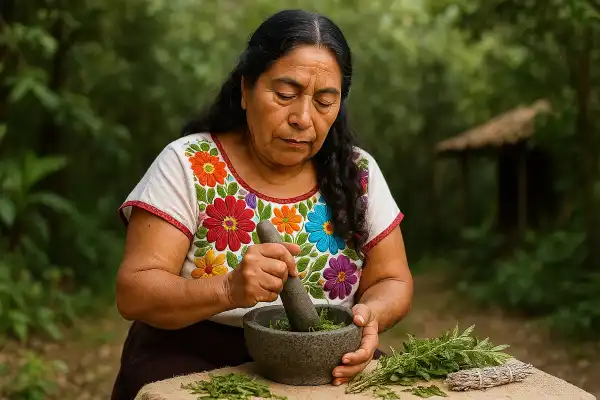What is curanderismo? This ancient question echoes through generations of families seeking wisdom beyond conventional medicine. In our modern world, where wellness often feels fragmented, many souls find themselves drawn to these sacred healing traditions that have sustained communities for over five centuries.
María del Pilar Fernández believes this growing curiosity stems from our collective longing to reconnect with holistic approaches that honor the interconnectedness of body, mind, and spirit. Through her work at RainyBlue.org, she seeks to illuminate the profound healing arts of curanderismo, sharing the ancestral knowledge that has been carefully preserved within Mexican indigenous communities.
For broken hearts, you should read “Can curandera heal heartbroken people?”
What is curanderismo?
Curanderismo is a comprehensive traditional healing system that encompasses the spiritual, emotional, physical, and mental well-being of individuals and communities. The term derives from the Spanish root “curar,” meaning “to cure,” and represents a practice that extends far beyond Western medicine by linking illness with spiritual imbalances and environmental disharmony.

This sacred healing tradition traces its roots back thousands of years to pre-Columbian Mesoamerican civilizations, including the Olmec and Aztec cultures. During Spanish colonization, curanderismo evolved into a rich synthesis of indigenous medicinal practices, Catholic rituals, and in some regions, African healing traditions brought by enslaved peoples. Rather than being diminished by this blending, the practice grew stronger, creating a resilient healing system that honors multiple cultural streams while maintaining its core indigenous wisdom.
The philosophy of curanderismo
Traditional curanderismo operates on the understanding that health encompasses three hierarchical realms: the material, mental, and spiritual dimensions of existence. Practitioners recognize that true healing requires addressing imbalances across all these levels, not merely treating isolated symptoms. This holistic perspective acknowledges that emotional states, spiritual disconnection, and environmental factors can manifest as physical ailments.
The practice is built upon eight fundamental philosophical premises that shape how both healers and patients understand the roots of disease, the nature of healing, and the sacred relationship between practitioner and client. Central to these beliefs is the understanding that divine providence plays a role in both illness and recovery, and that healing often involves restoring harmony between the individual and their community, environment, and spiritual essence.
Types of curanderos and their specializations
Within the curanderismo tradition, healers often specialize in particular areas of expertise. Yerberos focus primarily on herbal medicine, carrying deep knowledge of plant allies and their therapeutic properties. Hueseros specialize in treating bone and muscle ailments through manual therapy and energy work. Parteras serve as traditional midwives, supporting women through pregnancy, birth, and postpartum healing.
Oracionistas work primarily through the power of prayer and spiritual intervention, while sobadors provide therapeutic massage and bodywork. Some practitioners, known as tabaqueros, work specifically with sacred tobacco for healing purposes. Each specialization requires years of training and often involves a spiritual calling that guides the healer toward their particular gift.
Traditional healing modalities
The practice encompasses numerous healing modalities, including limpias (spiritual cleansings), herbal remedies, prayer, energy healing ceremonies, and therapeutic rituals. Limpias involve the use of eggs, herbs, or other sacred materials to remove negative energy and reveal spiritual blockages. These cleansings address what practitioners call “soul loss” or spiritual disconnection that can manifest as depression, anxiety, or physical illness.
Other common practices include the treatment of empacho (intestinal blockage), manteadas (shawl alignments for energy balancing), ventosas (fire cupping), and sobadas (traditional therapeutic massage). Temazcals, or traditional sweat lodges, provide ceremonial spaces for psychological, physiological, and spiritual healing through the combination of heat, steam, prayer, and community support.
Curanderismo in contemporary life
Research indicates that between 50-75% of Mexican Americans utilize traditional healing practices in certain regions of the United States. This widespread use demonstrates how curanderismo continues to serve as both a cultural anchor for immigrant communities and a bridge to maintain essential elements of identity and beliefs.
Modern practitioners often integrate curanderismo with conventional medical care, recognizing that both systems offer valuable contributions to healing. Many contemporary healers encourage clients to work with licensed healthcare providers while incorporating traditional remedies and spiritual practices as complementary support.
Universities such as the University of New Mexico now offer formal courses in curanderismo, marking a significant shift toward academic recognition of these traditional healing arts. This educational integration helps preserve ancestral knowledge while making it accessible to new generations of healers and healthcare providers.
The plant medicine tradition
Herbal medicine forms a cornerstone of curanderismo practice. Traditional remedies include aloe vera for burns, cuts, and digestive issues – uses now validated by modern research showing its anti-inflammatory and antibiotic properties. Papaya serves as a digestive aid for indigestion, while countless other plants provide therapeutic support for various conditions.
Each plant ally carries not only medicinal properties but also spiritual significance within the healing practice. Curanderas often maintain sacred relationships with their plant teachers, approaching herbalism as a form of communion with nature’s healing intelligence rather than merely extracting chemical compounds.
Cultural resilience and preservation
Despite facing persecution during colonial times and ongoing marginalization, curanderismo has demonstrated remarkable resilience, adapting to new environments while maintaining its essential healing wisdom. In places like New Mexico, practitioners speak of “reclaiming what has been lost” and working to revive traditions that connect people to their ancestral healing knowledge.
This revival represents more than nostalgia; it reflects a growing recognition that indigenous healing systems offer valuable insights for addressing contemporary health challenges, particularly those related to stress, trauma, and spiritual disconnection that conventional medicine often struggles to address effectively.
Disclaimer
Please note that Maria is not a physician, psychologist, or nurse. These culture-specific spiritual healing services are not meant to replace medical or psychological diagnosis and treatment. It is recommended that you see a licensed physician or licensed health care professional for any physical or psychological ailment you may have.
María recalls working with Elena, a young mother who came to her suffering from persistent nightmares and anxiety following a difficult divorce. After conventional therapy provided limited relief, Elena sought traditional healing support. Through a series of limpias and herbal remedies, combined with ceremonial work to address what María recognized as susto – a form of soul loss common after traumatic experiences – Elena began to regain her sense of wholeness. The healing process involved not only individual sessions but also reconnecting Elena with her grandmother’s stories and traditional foods, weaving back together the cultural threads that had been severed during her time of crisis. While Elena continued working with her therapist, the curandera practices provided the spiritual foundation that allowed her conventional treatment to become more effective.
